Cook’s home at Mile End
Blessed be to his wife and his Family too
God prosper them all and well for to do
Bless’d be unto them so long as they shall live
And that is the wish to them I do give.
A song composed by Thomas Perry on HMS Resolution
in appreciation of Captain Cook and his care for the welfare of the crew.
In 1764, Cook moved with his young family to a new terrace house at No. 7, Assembly Row, Mile End. This area on the outskirts of London was developing as a respectable and convenient location for those with an interest in maritime affairs: nearby were the fine houses of prosperous members of the East India Company, and along Mile End Road stood the Trinity Almshouses, built in 1695 to house the “decayed Masters and Commanders of ships or ye widows of such”1. From Cook’s home, he could look across the fields to Wapping and Shadwell, to the masts of ships in the Thames. Further down the river were the Deptford Dockyards where HMS Endeavour and HMS Resolution were fitted out in preparation for Cook’s voyages to the Pacific.
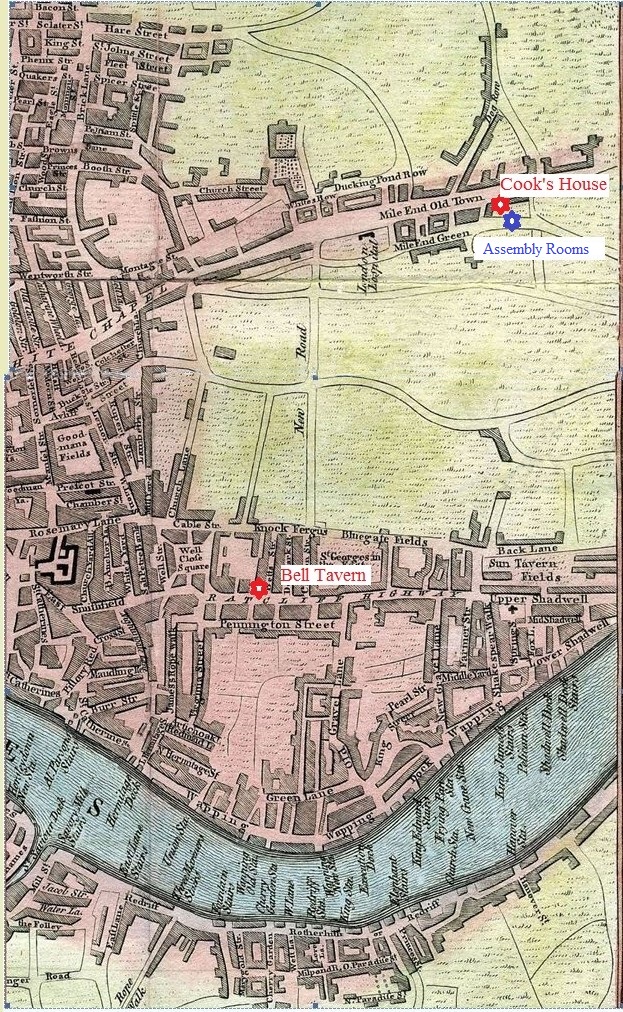
This map from 1767 shows Cook’s family home in Mile End Road, the Assembly Room, the Bell Tavern at Shadwell, and wharves along of the Thames.
Situated behind the Assembly Row terrace was the Mile End Assembly Room. In the 1700s, assembly rooms were important venues at a time when dancing was a noteworthy social activity; they also provided for meetings, concerts and other entertainments. This particular venue was celebrated in the dance Mile End Assembly, which was first published in 1748 and was reprinted four times over the next nine years2, reflecting its popularity. Very little is known about Cook’s personal or family life, and it is entirely possible that he took advantage of the proximity to the Assembly Rooms for dancing, tea-drinking and socialising on his days of leisure. It would have been a central meeting place for the owners and captains of ships in the East India Company, as well as officers in the Royal Navy who lived in the area; it may have provided Cook with the opportunity to meet people who could help advance his career.
Another place nearby where dancing was popular was the Bell Tavern. Just a short walk from the wharves, shops and warehouses which lined the bustling waterfront of the Pool of London, the Bell Tavern was one of the few reputable establishments in Shadwell offering food and lodgings to visiting seamen. Such public houses were also important places for recreation: music, dancing, singing, gambling. It seems Cook stayed at the Tavern on occasions in the years from 1746 to 1755, on his trips from Whitby to London, delivering cargoes of coal, wood, and other produce. It could take a week to unload a collier, during which time the crew was billeted in the wharf side taverns. He would have been aware that music and dance were key amusements for sailors and conducive to their well-being and good humour, a factor he recognised when encouraging his crew to dance on the long voyages in the Pacific.
![In 1757 the artist Louis Philippe Boitard produced a view of the Legal Quays, between Billingsgate Dock and the Tower of London.[1] Boitard's engraving, 'Imports from France', provided a satirical look at Londoners' passion for French luxury goods and manners. Although Boitard deliberately exaggerated the number of both people and shipping, he also provided the most accurate picture of the Legal Quays at work. Boitard recorded treadwheel cranes, beamscales, Customs' Officers gauging barrels and porters handling cargoes. Smuggling, theft and pilferage of cargoes were rife on both the busy open wharves and in the crowded warehouses. https://en.wikipedia.org/wiki/File:Imports_from_France_Boitard_1757.jpg [Public Domain]](/cms/wp-content/uploads/2019/08/Legal-Quays_Imports_from_France_Boitard_1757-300x173.jpg)
A scene familiar to Cook – the busy wharves along the Thames in 1757. Although the artist Louis Philippe Boitard exaggerated the crowding in the area, he accurately portrayed the activity of the docks.
Although Elizabeth knew about the lives of sea-faring men and the long separations which were the lot of sailors’ wives, little could she have anticipated the protracted voyages her husband undertook to the far side of the world. Of their 17 years of marriage, approximately four were spent together, before they were parted by his death in 1779. Elizabeth lived for another 56 years, surviving all six of their children. George, Joseph and Elizabeth died in infancy; Nathaniel, aged 15 died eight months after his father; Hugh died, aged 17, in 1793 from scarlet fever, and James, 31 drowned in 1794. Throughout her life Elizabeth maintained the greatest respect for her husband and regarded her memories as sacred. Prior to her death in 1835, she destroyed all their private records and correspondence. Little is known of their life together, but perhaps one of her happy reminiscences was dancing at the Mile End Assembly.
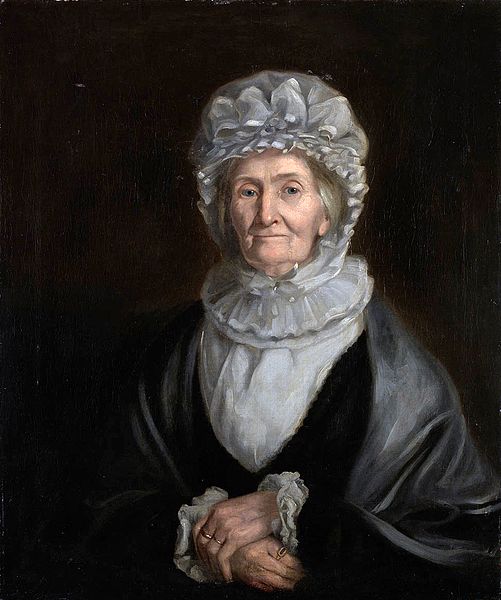
This portrait of Mrs Elizabeth Cook by William Henderson shows her aged 88 years in 1830. She remained devoted to the memory of her husband and proud of his accomplishments throughout her 56 years of widowhood. Courtesy of the State Library of New South Wales. (Public Domain).
Nothing remains of Cook’s home in Mile End. Despite the house being recognized as a significant historical building, it was demolished in 1958 to widen the the lane way. Now a plaque on a brick wall designates the site of his family home. The location of the once famous Assembly Room is still marked by a thoroughfare named Assembly Passage.
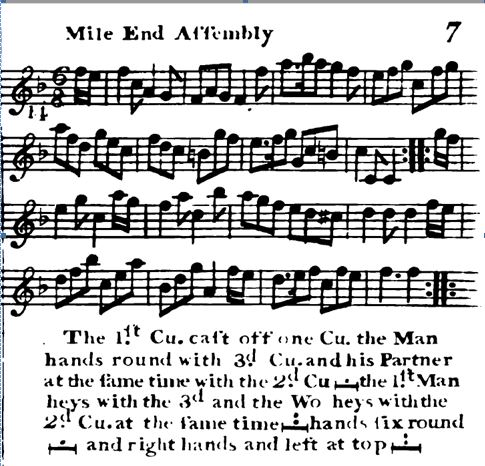
Music and dance instructions for the Mile End Assembly.
Thompson’s 200 Favourite Country Dances Vol 1 (c.1757).
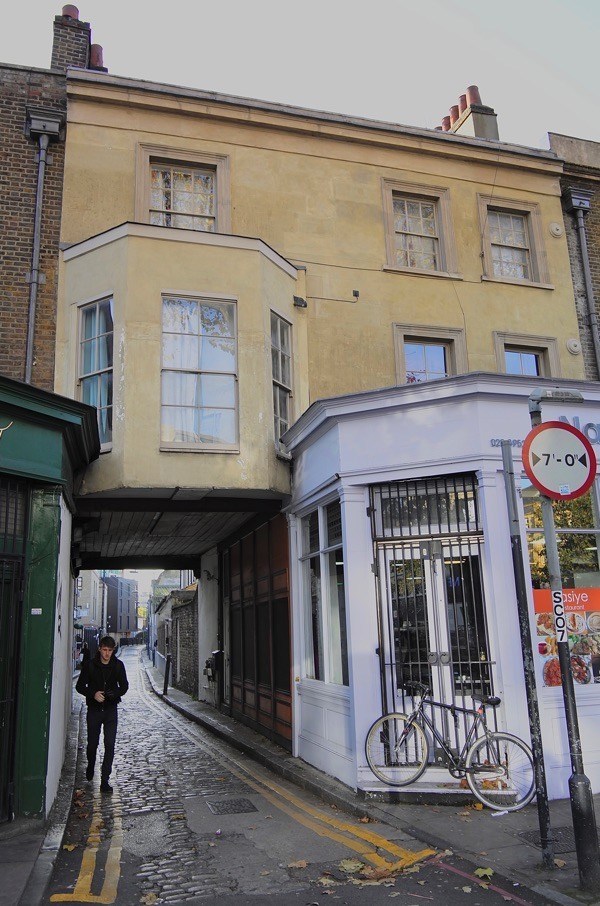
The only relic of the Mile End Assembly Rooms is the laneway called Assembly Passage, which once lead from Mile End Road through to the Rooms. Photo courtesy of the Gentle Author.
Music by Philip’s Dog: Roland Clarke (violin) Now available on our CD
Country dance: Triple minor longways.
| A1 | 1-4 | 1st couple cast into 2nd place, 2nd couple moves up |
| 5-8 | 1st man circles left with 2nd couple, whilst 1st lady circles left with 3rd couple | |
| A1 | 1-8 | 1st man heys with 2nd couple, whilst 1st lady heys with 3rd couple. 1st couple finishes in 2nd place |
| B1 | 1-8 | All three couples circle left and right |
| B2 | 1-8 | 2nd and 1st couples dance rights and lefts |
Three couple version: 1st couple move into 3rd place at the end of the rights and lefts, 3rd couple moves up into 2nd place.
Footnotes
1 The plaque on the Almshouse building bears this inscription. https://alondoninheritance.com/london-buildings/new-deal-for-east-london-stepney-green/
2 Walsh’s Caledonian Collection Volume 2 Part 1 (c.1750), Johnson’s 200 Country Dances Volume 6 (1751), Thompson’s 24 Country Dances (1752), Willsim Recueil de 24. Contredances Angloise les plus usite (1755), Thompson’s 200 Country Dances Vol 1 (c.1757). In addition, another version of the dance, New Mile End Assembly, was published in Bride’s 24 Country Dances (1768); Longman & Broderip’s 200 Country Dances (1781)
3 British Library, Crace Collection Of Maps Of London. A drawn map of London, Westminster and Southwark 1770. http://www.bl.uk/onlinegallery/onlineex/crace/other/007zzz000000004u00136000.html
4 Advertisements and Notices. (1769, October 18). Public Advertiser. Retrieved from https://link.gale.com/apps/doc/Z2001132824/GDCS?u=bccl&sid=GDCS&xid=8aeaeffe
Select Bibliography
Clarke, H. B. (2014). Captain Cook’s Country Dance. Australian Folklore, 29 (November 2014), 71-86. https://eprints.qut.edu.au/94508/
Collingridge, V. (2003). Captain Cook Obsession and Betrayal in the New World. Great Britain: Ebury Press.
Edwards, P. (Ed.) (1999). The Journals of Captain Cook. London: Penguin Books
Gardner, P. (1983). Cook’s Stepney. Cook’s Log, 6(3). https://www.captaincooksociety.com/home/detail/cook-s-stepney-now-named-tower-hamlets
Rodger, N. A. M. (1986). The Wooden World. An Anatomy of the Georgian Navy. London: Collins.
Stone, P. (2018). New Deal For East London – Stepney Green. A London Inheritance. Retrieved from https://alondoninheritance.com/london-buildings/new-deal-for-east-london-stepney-green
Tindall, G. (2019). At Captain Cook’s House In Mile End Rd. Spitalfield’s Life. Retrieved from http://spitalfieldslife.com/2018/02/11/at-captain-cooks-house-in-mile-end-rd/
Republished with permission
In Spitalfield’s Life in the East End of London. 16 November, 2019.
https://spitalfieldslife.com/2019/11/16/the-mile-end-assembly/
______________________________________________________________
This resource was created on the lands of the Gubbi Gubbi people.
We pay our respects to their elders past and present.
Sovereignty was never ceded.
______________________________________________________________
Header credits:
1. Portrait of Captain Cook by Nathaniel Dance-Holland [Public domain]
2. A jig on board by Cruikshank. Courtesy of The Lewis Walpole Library, Yale University
3. View of the South Seas by John Cleveley the Younger [Public domain]
______________________________________________________________
The information on this website www.historicaldance.au may be copied for personal use only, and must be acknowledged as from this website. It may not be reproduced for publication without prior permission from Dr Heather Blasdale Clarke.

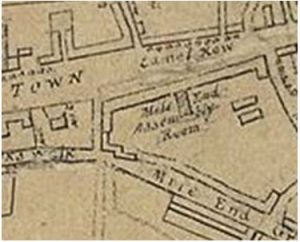
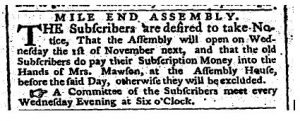
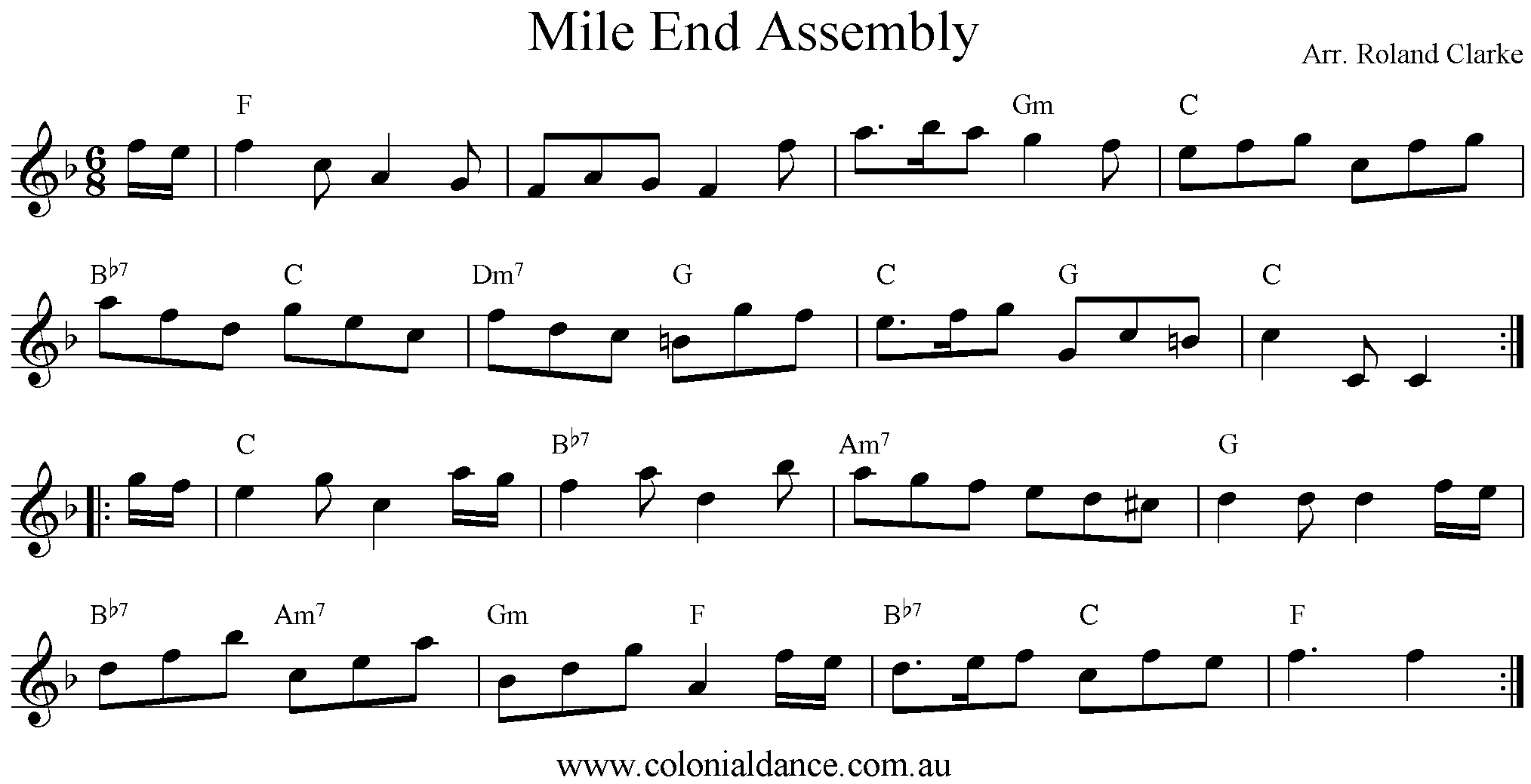


4 Responses to Mile End Assembly